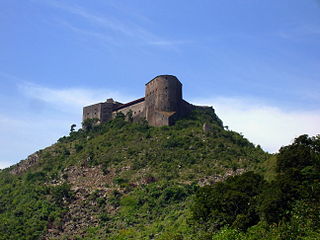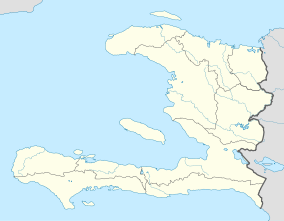
Henri Christophe was a key leader in the Haitian Revolution and the only monarch of the Kingdom of Haiti.

Cap-Haïtien, typically spelled Cape Haitien in English and often locally referred to as Le Cap, Okap or Au Cap, is a commune of about 274,000 people on the north coast of Haiti and capital of the department of Nord. Previously named Cap‑Français and Cap‑Henri during the rule of Henri I, it was historically nicknamed the Paris of the Antilles, because of its wealth and sophistication, expressed through its architecture and artistic life. It was an important city during the colonial period, serving as the capital of the French Colony of Saint-Domingue from the city's formal foundation in 1711 until 1770 when the capital was moved to Port-au-Prince. After the Haitian Revolution, it became the capital of the Kingdom of Haiti under King Henri I until 1820.

Nord (French) or Nò is one of the ten departments of Haiti and located in northern Haiti. It has an area of 2,114.91 km2 (816.57 sq mi) and a population of 1,067,177 (2015). Its capital is Cap-Haïtien.
The culture of Haiti is a creolized blend of African, European and Taino elements due to the French colonization of Amerindian land, in conjunction with the large diverse enslaved African population whom had later freed themselves by a successful revolt. These attributions have largely influenced the art, cuisine, literature, music, religion as well as the languages of Haiti.

The Citadelle Laferrière, commonly known as La Citadelle, is a large early 19th-century fortress located in Milot in Nord, Haiti. It is situated on the Bonnet à l'Evêque mountaintop located approximately 8 kilometres (5.0 mi) uphill from the town of Milot, 27 kilometres (17 mi) south of the city of Cap-Haïtien, and 15 kilometres (9.3 mi) southwest of the Three Bays Protected Area.

The Palace of Sans-Souci, or Sans-Souci Palace, was the principal royal residence of Henry I, King of Haiti, better known as Henri Christophe. It is located in the town of Milot, approximately five kilometres (3 mi) northeast of the Citadelle Laferrière, and thirteen kilometres (8 mi) southwest of the Three Bays Protected Area. Being among the first buildings constructed in a free Haiti after the Haitian Revolution, the Palace and the neighboring Citadelle, are Haitian icons and global symbols of liberty, and were inscribed on the World Heritage List in 1982.

The Kingdom of Haiti, or Kingdom of Hayti was the state established by Henri Christophe on 28 March 1811 when he proclaimed himself King Henri I after having previously ruled as president of the State of Haiti, in the northern part of the country. This was Haiti's second attempt at monarchical rule, as Jean-Jacques Dessalines had previously ruled over the First Empire of Haiti as Emperor Jacques I from 1804 until his assassination in 1806.
The Massif de la Hotte is a mountain range in southwestern Haiti, on the Tiburon Peninsula. About 2.5 million years ago, Massif de la Hotte was separated from the Massif de la Selle by a deep, wide sea channel, and formed a separate island. This resulted in a hotbed of endemism in la Hottes bird, plant, and reptile communities. The Massif de la Hotte is subdivided into the Oriental la Hotte in the East, the central la Hotte and the Occidental la Hotte on the Western tip of the Tiburon peninsula. The Occidental la Hotte is relatively remote and is one of the most biologically diverse and significant areas of all of Hispaniola. It also supports some of the last stands of Haiti's dense cloud forest on its peaks.

Milot is a commune in the Nord department of Haiti, 12 miles south of Cap-Haïtien. It is the site of Sans-Souci Palace, one of Haiti's most revered landmarks. The Citadelle Laferrière, Haiti's best-known landmark, is five miles (8 km) by road to the south. The town also hosts a hospital, Hôpital Sacré Coeur, run by the Sovereign Military Order of Malta and the Crudem Foundation.
Tourism in Haiti is an industry that generated just under a million arrivals in 2012, and is typically one of the main sources of revenue for the nation. With its favorable climate, second-longest coastline of beaches, and most mountainous ranges in the Caribbean, waterfalls, caves, colonial architecture and distinct cultural history, Haiti has had its history as an attractive destination for tourists. However, unstable governments have long contested its history and the country's economic development throughout the 20th century.
The Institut de Sauvegarde du Patrimoine National (ISPAN), the Haitian Institute for the Protection of National Heritage, was founded in 1979 and has since been active. In addition to the extensive restorations at the Citadelle Henry, the Sans-Souci Palace, the Cathedral of Cap-Haïtien, Fort Jacques de Fermathe and the National Palace in Port-au-Prince, ISPAN undertook numerous studies and investigations that have resulted in a list with more than a thousand properties of cultural value located throughout Haiti. In 1994, ISPAN managed to officially rank thirty-three historical monuments and the historic center of Cap-Haïtien under National Heritage. This was an important step towards an active and effective management by the state.

Albert Mangonès, was a Haitian architect.

Three Bays Protected Area, also known as Three Bays National Park, is a protected area in northeastern Haiti. It protects coral reefs, seagrass beds, mangrove forests, and dry forests.
Galland Semerand was a Haitian painter and architect.

On April 12, 2020, at 3 AM, a structure fire broke out beneath the roof of the Royal Chapel cathedral in Milot, Haiti. By the time firefighters arrived to stop the fire from spreading, the dome of the cathedral had collapsed and the rest of the building was already badly burnt. The dome collapsed, causing the loss of everything inside the building.

The Palace de la Belle Rivière is a former palace in Petite Rivière de l'Artibonite, in the Artibonite department of Haiti. It is also known as the ‘’palace of 365 doors’’. Although, it has not 365 doors. The palace was built for the first and last king of Haiti, Henri Christophe I. It overlooks the city center and the Artibonite River. Today, the palace ruins are in poor condition and deteriorating.


















